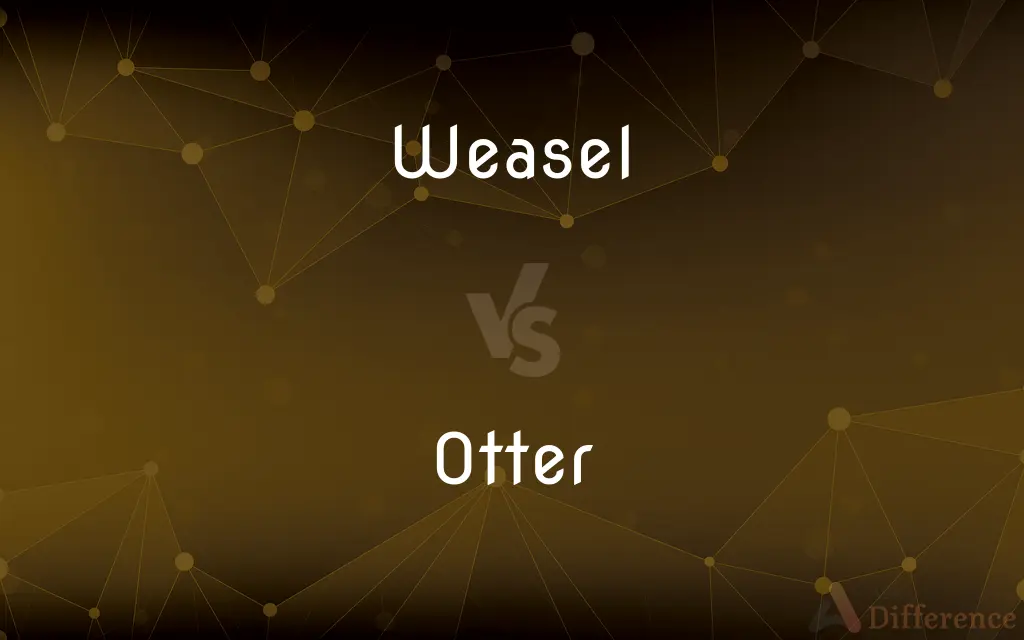Weasel vs. Otter — What's the Difference?
Edited by Tayyaba Rehman — By Fiza Rafique — Updated on March 25, 2024
Weasels are small, carnivorous mammals known for their slender bodies and predation skills, mainly on rodents, while otters are larger, aquatic members of the same family, adept at fishing and known for their playful nature.

Difference Between Weasel and Otter
Table of Contents
ADVERTISEMENT
Key Differences
Weasels are part of the Mustelidae family, characterized by their elongated bodies, short legs, and carnivorous diet, primarily focusing on hunting small mammals like rodents. They are known for their agility and ability to access the burrows of their prey. On the other hand, otters, also belonging to the Mustelidae family, are adapted to aquatic life, with strong, webbed feet for swimming and dense fur for insulation in cold water. Their diet mainly consists of fish, making them skilled swimmers and divers.
While weasels are generally solitary animals, focusing on their prowess in hunting and their ability to navigate through tight spaces to catch prey, otters are more social. Otters often live in groups and are known for their playful behavior, which includes sliding down riverbanks and playing with objects or each other. This social nature contrasts sharply with the more solitary and stealthy lifestyle of weasels.
The habitats of weasels and otters also highlight their differences. Weasels can be found in a variety of environments, from woods and fields to farms, where they hunt terrestrial prey. Otters, however, are closely tied to watery landscapes like rivers, lakes, and coastal areas, where their adaptations to water allow them to thrive and find food.
In terms of reproductive behavior, weasels have a unique mechanism called delayed implantation, where the fertilized egg remains dormant before implanting in the uterus and resuming development. This allows for flexible timing of birth to favorable conditions. While some otter species also exhibit delayed implantation, their reproductive strategies are more varied and can include complex social structures for raising young, which is a distinction from the more straightforward breeding practices of weasels.
Finally, the impact of each on human perception and culture differs. Weasels, while admired for their hunting abilities, often carry negative connotations in folklore and language, symbolizing slyness or deceit. Otters, conversely, are frequently viewed positively, symbolized as playful and intelligent creatures in various cultural narratives and media.
ADVERTISEMENT
Comparison Chart
Size and Body Shape
Small and slender, adapted for hunting in burrows.
Larger, robust, and adapted to aquatic environments.
Habitat
Woods, fields, and farms.
Rivers, lakes, and coastal areas.
Diet
Primarily small mammals like rodents.
Mainly fish, but can include crustaceans and other aquatic organisms.
Social Behavior
Solitary, with a focus on stealthy hunting.
Social, known for playful behavior and living in groups.
Reproduction
Delayed implantation common, leading to flexible birth timing.
Varied, with some species exhibiting delayed implantation. Complex social structures for rearing young.
Human Perception
Often viewed negatively, associated with slyness.
Generally viewed positively, seen as playful and intelligent.
Compare with Definitions
Weasel
Symbol of cunning.
In folklore, the weasel is often depicted as a cunning and sly creature.
Otter
Aquatic, social mammals.
The family of otters played together in the river, sliding down the muddy banks.
Weasel
Known for slender bodies.
The weasel slipped into the narrow burrow to catch its prey.
Otter
Diverse habitats near water.
Otters make their homes in rivers, lakes, and coastal areas where they can easily find food.
Weasel
Adaptable to various terrains.
Weasels can thrive in both wooded areas and open fields.
Otter
Positive cultural symbols.
Otters are often celebrated in stories and media for their intelligence and playful antics.
Weasel
Solitary hunters.
A weasel typically hunts alone, using its agility to capture small mammals.
Otter
Playful nature.
Otters are known for their playful behavior, including sliding on their bellies and juggling stones.
Weasel
Small, carnivorous mammals.
The farmer appreciated the weasel for keeping the rodent population under control.
Otter
Skilled swimmers and divers.
Otters use their webbed feet and streamlined bodies to dive and catch fish.
Weasel
Weasels are mammals of the genus Mustela of the family Mustelidae. The genus Mustela includes the least weasels, polecats, stoats, ferrets and mink.
Otter
Otters are carnivorous mammals in the subfamily Lutrinae. The 13 extant otter species are all semiaquatic, aquatic or marine, with diets based on fish and invertebrates.
Weasel
Any of various carnivorous mammals of the genus Mustela, having a long slender body, a long tail, short legs, and brownish fur that in many species turns white in winter.
Otter
A semiaquatic fish-eating mammal of the weasel family, with an elongated body, dense fur, and webbed feet.
Weasel
A person regarded as sneaky or treacherous.
Otter
A piece of board used to carry fishing bait in water.
Weasel
To be evasive; equivocate.
Otter
Any of various aquatic or semiaquatic carnivorous mammals of the mustelid subfamily Lutrinae, having webbed feet and dense, dark brown fur.
Weasel
The least weasel, Mustela nivalis.
Otter
The fur of one of these animals.
Weasel
Any of the carnivorous mammals of the genus Mustela, having a slender body, a long tail and usually a light brown upper coat and light-coloured belly.
Otter
An aquatic or marine carnivorous mammal in the subfamily Lutrinae of the family Mustelidae, which also includes weasels, polecats, badgers, and others.
Weasel
The taxonomic family Mustelidae is also called the weasel family.
Otter
(gay slang) A hairy man with a slender physique, in contrast with a bear, who is more thickset.
Weasel
A devious or sneaky person or animal.
Otter
(obsolete) annatto dye
Weasel
A type of yarn winder used for counting the yardage of handspun yarn. It most commonly has a wooden peg or dowel that pops up from the gearing mechanism after a certain number of yards have been wound onto the winder.
Otter
The larva of the ghost moth. It is very injurious to hop vines.
Weasel
(transitive) To achieve by clever or devious means.
Otter
A corruption of Annotto.
Weasel
To gain something for oneself by clever or devious means.
Otter
The fur of an otter
Weasel
(intransitive) To engage in clever or devious behavior.
Otter
Freshwater carnivorous mammal having webbed and clawed feet and dark brown fur
Weasel
Small carnivorous mammal with short legs and elongated body and neck
Common Curiosities
Are otters social or solitary animals?
Otters are social animals and often live in groups.
What family do both weasels and otters belong to?
They both belong to the Mustelidae family.
How do otters contribute to their ecosystem?
Otters contribute by controlling fish populations and maintaining healthy aquatic ecosystems.
Can otters live in marine environments?
Yes, some otter species live in coastal and marine environments.
What are some playful behaviors of otters?
Otters engage in sliding down riverbanks and playing with objects or each other.
How do otters use tools?
Some otter species use rocks to crack open shellfish, showing tool use and intelligence.
How do weasels and otters differ in their habitats?
Weasels live in a variety of terrestrial environments, while otters are adapted to aquatic habitats.
How do weasels hunt their prey?
Weasels hunt their prey through agility and the ability to enter narrow spaces like burrows.
What role do weasels play in controlling rodent populations?
Weasels help control rodent populations by preying on them.
What is the primary diet of weasels?
Weasels primarily eat small mammals like rodents.
Why might weasels be viewed negatively in folklore?
Because of their stealthy hunting techniques and the symbolic association with slyness and deceit.
How are otters important in water ecosystems?
By preying on fish and other aquatic organisms, otters play a crucial role in maintaining the balance of aquatic ecosystems.
Do weasels and otters exhibit similar reproductive strategies?
Both can exhibit delayed implantation, but otters may have more complex social structures for rearing young.
What kind of environments do weasels prefer?
Weasels can adapt to a range of environments but prefer those where they can easily hunt their prey.
What makes otters adept at swimming?
Otters have webbed feet, dense fur for insulation, and streamlined bodies, making them skilled swimmers.
Share Your Discovery

Previous Comparison
Exactly vs. Identical
Next Comparison
Appropriacy vs. AppropriatenessAuthor Spotlight
Written by
Fiza RafiqueFiza Rafique is a skilled content writer at AskDifference.com, where she meticulously refines and enhances written pieces. Drawing from her vast editorial expertise, Fiza ensures clarity, accuracy, and precision in every article. Passionate about language, she continually seeks to elevate the quality of content for readers worldwide.
Edited by
Tayyaba RehmanTayyaba Rehman is a distinguished writer, currently serving as a primary contributor to askdifference.com. As a researcher in semantics and etymology, Tayyaba's passion for the complexity of languages and their distinctions has found a perfect home on the platform. Tayyaba delves into the intricacies of language, distinguishing between commonly confused words and phrases, thereby providing clarity for readers worldwide.















































